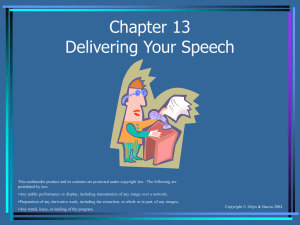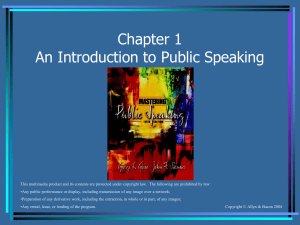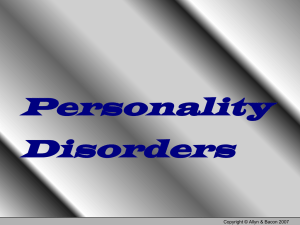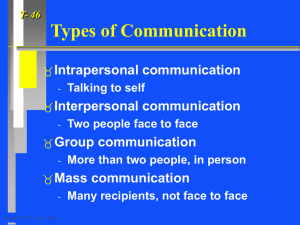Essentials of Human Communication, 6/e Verbal Messages
advertisement
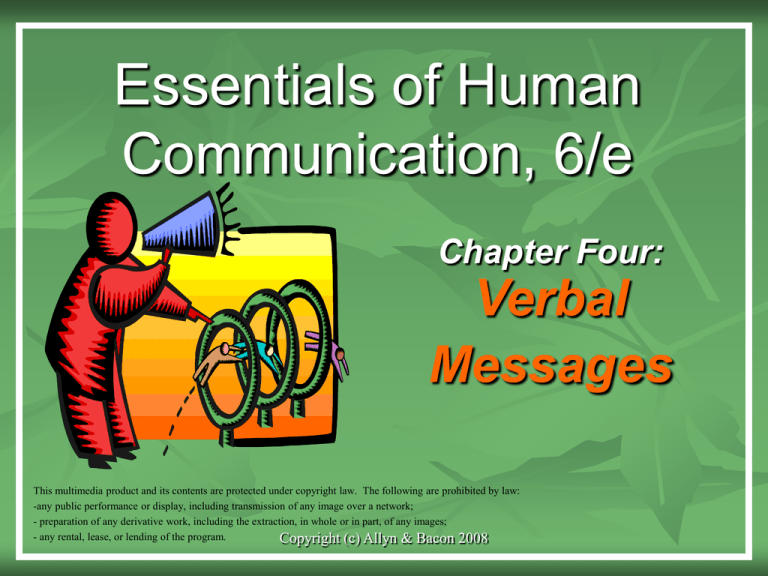
Essentials of Human Communication, 6/e Chapter Four: Verbal Messages This multimedia product and its contents are protected under copyright law. The following are prohibited by law: -any public performance or display, including transmission of any image over a network; - preparation of any derivative work, including the extraction, in whole or in part, of any images; - any rental, lease, or lending of the program. Copyright (c) Allyn & Bacon 2008 Five Principles of Verbal Messages 1. 2. 3. 4. 5. Messages are denotative and connotative. Messages vary in abstraction. Messages vary in directness. Message meanings are in people. Messages are influenced by culture and gender. Copyright (c) Allyn & Bacon 2008 Human Communication Messages are culturally influenced. Copyright (c) Allyn & Bacon 2008 Cultural Principles of Communication The principle of cooperation The principle of peaceful relations The principle of face-saving The principle of self-denigration The principle of directness The principle of politeness Copyright (c) Allyn & Bacon 2008 Human Communication Disconfirmation o A communication pattern in which one ignores the other person’s presence and communication Confirmation o A communication pattern in which one acknowledges the other person’s presence and attends to his/her communication Copyright (c) Allyn & Bacon 2008 Human Communication Disconfirmation Confirmation Acknowledge presence and contribution of other Make nonverbal contact Demonstrate under-standing of words and feelings Ask questions Encourage the other person to express thoughts and feelings Ignore presence and indifferent to messages Make no nonverbal contact Jump to interpret and evaluate messages Talk about self Interrupt; make it hard for other’s expression Copyright (c) Allyn & Bacon 2008 Racism Classifying others in an inferior position Makes dominant group more powerful Inherently racist language—“white” Commonly called “cultural identifiers”(i.e. descriptions like old, black, Jew, queer) Learn to use appropriate identifiers Copyright (c) Allyn & Bacon 2008 Heterosexism “derogatory language used against gays or lesbians” Avoid offensive parodies and ambiguous compliments Avoid assumptions about their relational knowledge of other people “like them” Affirm them as individuals Stay clear of making overattributions Remember and celebrate relationship milestones Copyright (c) Allyn & Bacon 2008 Ageism o o o Prejudice against other age groups General disrespect for older people Age restrictions in certain occupations Copyright (c) Allyn & Bacon 2008 Sexism o o o o o Sexist language—either inclusive or exclusive Generic “man” Generic “he” and “his” Sex role stereotyping Gender-free language Copyright (c) Allyn & Bacon 2008 Sexual Harassment • Quid pro quo harassment • Hostile environment harassment Copyright (c) Allyn & Bacon 2008 Cultural Identifiers Lady vs. Woman Older person vs. Elderly African American vs. Black Indian vs. Native American Other examples? Copyright (c) Allyn & Bacon 2008 Using Verbal Messages Effectively Language symbolizes (but is not) reality Language expresses both facts and inferences that must be distinguished Language can obscure important distinctions among peoples Copyright (c) Allyn & Bacon 2008 Messages Symbolize Parts of Reality. Intensional Orientation: Viewing people, objects, or events in the way they are talked about or pre-labeled Extensional Orientation: Look first at the actual people, objects or events and then apply labels Allness thinking—putting into “all” or “never” categories Copyright (c) Allyn & Bacon 2008 Messages Express Both Facts and Inferences. Fact-inference confusion To avoid the confusion, remember inferences are made when anyone presents “facts.” A good rule of thumb: A fair factual statement is made by a person who describes what s/he observes and limits it to that information only. Copyright (c) Allyn & Bacon 2008 Messages Can Obscure Distinctions Indiscrimination: Failure to distinguish between similar but different people Solution: See the individual apart from the group Polarization: Tendency to see the world in opposite extremes Solution: Search for the middle ground People and things change at a rapid rate but our messages may not keep pace. Copyright (c) Allyn & Bacon 2008

